 As UHN's monthly research newsletter, NRx reports on the full spectrum of leading research from UHN's five research institutes: the Princess Margaret (PM) Cancer Centre, the Toronto General Research Institute (TGRI), the Toronto Western Research Institute (TWRI), the Toronto Rehabilitation Institute (TRI) and the Techna Institute (Techna).
As UHN's monthly research newsletter, NRx reports on the full spectrum of leading research from UHN's five research institutes: the Princess Margaret (PM) Cancer Centre, the Toronto General Research Institute (TGRI), the Toronto Western Research Institute (TWRI), the Toronto Rehabilitation Institute (TRI) and the Techna Institute (Techna).
In this issue you can read about:
- A blood molecule implicated in lupus
- A new molecular target for leukemia
- Microbubbles in the fight against cancer
- The link between depression and the fear of falling
- Personalized treatment for schizophrenia
- Detecting Parkinson disease earlier
We hope that you will find NRx informative. If you have feedback or questions, please contact www@uhnresearch.ca.
Christopher J. Paige, PhD, FCAHS
Vice President, Research
University Health Network
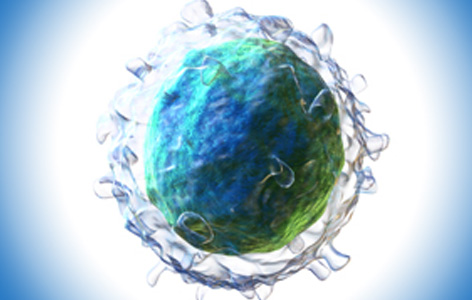
The B cell (illustrated above) is an important part of the immune system, but can target the body's own tissues in diseases like lupus.
In the immune system, B cells are responsible for identifying invading viruses and bacteria and releasing antibodies that target these threats. In the autoimmune disease systemic lupus erythematosus, commonly known as lupus, B cells behave differently—they mis-identify healthy tissues and signal the immune system to attack. Why these cells target healthy tissue in lupus is still a mystery.
TWRI Senior Scientist Dr. Joan Wither and colleagues have helped shed light on this. The team showed that B cell behaviour changed over time and did not match up with the genetic risk factors of the patients, suggesting that another influence was at play.
In a key experiment, the research team placed B cells from healthy donors into blood plasma from someone with lupus, which caused the formerly healthy cells to behave just like those in lupus. These results indicated that something in the blood causes the change in B cell behaviour. Further tests demonstrated that this abnormal B cell behaviour was being influenced by a molecule known as interferon-alpha (IFN-α) that is normally increased in the body during an infection.
The identification of IFN-α as a key player in the disturbance of B cell behaviour in lupus represents an important first step towards the development of new therapies to restore normal B cell function.
This work was supported by the Canadian Institutes of Health Research, the Arthritis Society, the Arthritis Centre of Excellence, the Arthritis Research Foundation and the Toronto General & Western Hospital Foundation. PR Fortin is a Tier 1 Canada Research Chair in Systemic Autoimmune Rheumatic Diseases. Image courtesy of Blausen gallery 2014. Wikiversity Journal of Medicine. DOI:10.15347/wjm/2014.010
Interferon-α induces altered transitional B cell signaling and function in Systemic Lupus Erythematosus. Chang NH, Li TT, Kim JJ, Landolt-Marticorena C, Fortin PR, Gladman DD, Urowitz MB, Wither JE. Journal of Autoimmunity. 2015 Feb 9. [Pubmed abstract]
Acute myeloid leukemia (AML) is a type of blood cancer, characterized by the rapid growth of immature white blood cells that accumulate in the bone marrow and interfere with the production of normal blood cells. Unless treated, AML is associated with infection, organ failure, bleeding and death. In some cases, complete remission can be achieved with initial chemotherapy treatment but there is still a significant population of AML patients for which this does not occur. Despite many advances in understanding how AML develops and progresses, there is still a clear need to identify better predictors of therapy response and outcomes.
A recent study led by PM Cancer Centre Affiliate Scientist Dr. Leonardo Salmena and his team examined the association of INPP4B—an enzyme in an important signalling pathway that contributes to cancer development—with various clinical measures in AML. They observed that AML patients with high levels of expression of the INPP4B gene had poor response to initial chemotherapy and shorter overall survival. Moreover, when investigating its role in experimental AML cell lines, overexpression of the INPP4B gene enhanced cell proliferation and recapitulated the chemotherapy resistance observed in AML patients.
"The consistency of these results across several datasets suggests that INPP4B expression could be a robust biomarker for AML regardless of the planned therapy," says Irakli Dzneladze, lead author on the paper. "It may also be a promising target for future AML therapies."
This work was supported by the Leukemia and Lymphoma Society of Canada, and The Princess Margaret Cancer Foundation.
INPP4B overexpression is associated with poor clinical outcome and therapy resistance in acute myeloid leukemia. Dzneladze I, He R, Woolley JF, Son MH, Sharobim MH, Greenberg SA, Gabra M, Langlois C, Rashid A, Hakem A, Ibrahimova N, Arruda A, Minden MD, Salmena L. Leukemia. 2015 March 4. [Pubmed abstract]
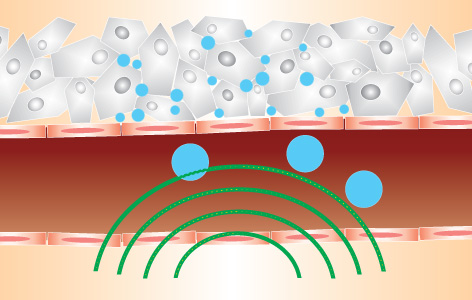
Porphyrin microbubbles (blue) travel through blood vessels to the tumour (white), where they are converted into nanoparticles by ultrasound waves (green).
Image-guided cancer therapies rely on the ability to visualize a malignant tumour so that treatment is applied only at that location. This is achieved by injecting a "contrast agent"—a compound that selectively accumulates in cancerous tissue and can be observed by medical imaging methods.
One of the most highly customizable types of contrast agents is a microbubble. These bubbles are very small (1 to 5 microns in diameter) and consist of a shell and gas core. Although they can be readily detected by ultrasound imaging, microbubbles burst when they are exposed to ultrasound. This makes them unusable for imaging purposes, as they can only help visualize tumours over a short window of time.
To address this issue, Techna Core Lead and PM Senior Scientist Dr. Gang Zheng invented microbubbles made of a compound called porphyrin. Porphyrin microbubbles still burst when they are exposed to ultrasound imaging, but their remnants form porphyrin nanoparticles that stay within the tumour and can be visualized. Microbubbles are versatile; they can be loaded with drugs within the gas core and when they burst, the drug is delivered directly to the tumour. Moreover, they can be visualized using imaging methods other than ultrasound.
"To our knowledge, this is the first study to explore the conversion of microbubbles into nanoparticles," says Dr. Zheng. "These improved microbubbles can be visualized for longer, enabling clinicians to apply treatments more accurately and minimize damage to the surrounding healthy tissue. Coupled with the fact that microbubbles can act as drug carriers, they represent a powerful new tool with which to specifically target cancerous tumours."
This work was supported by the Canadian Institutes of Health Research, the Canadian Space Agency, the Natural Sciences and Engineering Research Council of Canada, the Ontario Institute for Cancer Research, the Ministry of Knowledge Economy, South Korea, the Joey and Toby Tanenbaum/Brazilian Ball Chair in Prostate Cancer Research, the Canada Foundation for Innovation and the Princess Margaret Cancer Foundation.
In situ conversion of porphyrin microbubbles to nanoparticles for multimodality imaging. Huynh E, Leung BY, Helfield BL, Shakiba M, Gandier JA, Jin CS, Master ER, Wilson BC, Goertz DE, Zheng G. Nature Nanotechnology. 2015 Mar 30. [Pubmed abstract]

Falls are a leading cause of hospitalization for seniors, but exercise and balance training can help reduce the risk.
Falling is a major problem for the aging population: older individuals are more likely to fall and the consequences of falling become more severe with age. Those who fall can potentially develop a fear of falling, and this can lead them to reduce their engagement in daily activities, resulting in social isolation, loss of physical fitness and a reduced quality of life. Falls prevention programs (FPP), including those offered by Toronto Rehab, commonly use balance training, low-intensity exercise and attention to risk factors to reduce the risk of falls and to manage the fear of falling.
Depression is closely linked to this phenomenon—depressed individuals are more likely to experience a stronger fear of falling, although it is not clear whether this fear and the associated impacts on activities and social isolation contributes to causing the depression, or whether depression increases the fear of falling. A study by TGRI Senior Scientist and TRI Affiliate Scientist Dr. Alastair Flint has highlighted depression as an aspect of this emotion that can be helped through FPPs. Study participants in FPPs at UHN and Sunnybrook who experienced an improvement in their depression also had the greatest reduction in their fear of falling, in part because they had the most room for improvement.
"Based on the results of this study, interventions that target depression and falls together would be useful additions to a FPP," concludes Dr. Flint.
This work was supported by the Canadian Institutes of Health Research, the UHN Department of Psychiatry Research Fund and the Toronto Rehab Foundation.
Depression and outcome of fear of falling in a falls prevention program. Iaboni A, Banez C, Lam R, Jones SA, Maki BE, Liu BA, Flint AJ. The American Journal of Geriatric Psychiatry. 2015 Feb 16. [Pubmed abstract]
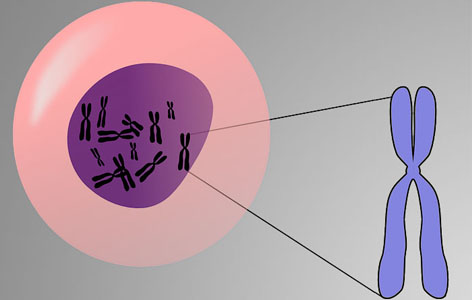
Most human cells carry 23 pairs of chromosomes. In the diagram, one chromosome pair is represented by the x-shaped structure shown in blue.
Schizophrenia is a brain disorder that causes people to experience hallucinations, delusions and disordered thinking. Selecting the right combination of medication and dosage to treat each patient's symptoms remains a significant challenge.
One possible solution to this problem is the use of genetic testing to help identify which treatments may work best at what dose for which individuals. Recently, TGRI Senior Scientist Dr. Anne Bassett showed that this approach may provide new insight into the clinical effects of clozapine—an important drug prescribed to treat schizophrenia.
The study, led by PhD student Nancy Butcher, examined the medical records of 40 people with schizophrenia who had been prescribed clozapine. Half of these people had a genetic form of schizophrenia caused by a small missing piece of chromosome 22, known as the 22q11.2 deletion syndrome. Chromosomes consist of DNA and proteins and contain the majority of a person's genetic information. Researchers found that people with the 22q11.2 deletion could be treated with significantly lower doses of clozapine than those with a full chromosome. Moreover, they showed that people with the 22q11.2 deletion were more likely to experience serious—though largely manageable—side effects such as seizures, dangerously low levels of white blood cells and inflammation of the heart wall.
"These findings serve as a proof-of-principle for personalized medicine in psychiatry and provide evidence of the utility of clinical genetic testing for schizophrenia." says Dr. Bassett.
This work was supported by the Canadian Institutes of Health Research, Brain Canada, the Brain and Behavior Research Foundation, the Toronto General & Western Hospital Foundation, the Dalglish Chair in 22q11.2 Deletion Syndrome, and The Dalglish Family Hearts and Minds Clinic for Adults with 22q11.2 Deletion Syndrome. Dr. Bassett holds a Tier 1 Canada Research Chair in Schizophrenia Genetics and Genomic Disorders.
Response to clozapine in a clinically identifiable subtype of schizophrenia. Butcher NJ, Fung WL, Fitzpatrick L, Guna A, Andrade DM, Lang AE, Chow EW, Bassett AS. The British Journal of Psychiatry. 2015 March 5. [Pubmed abstract]
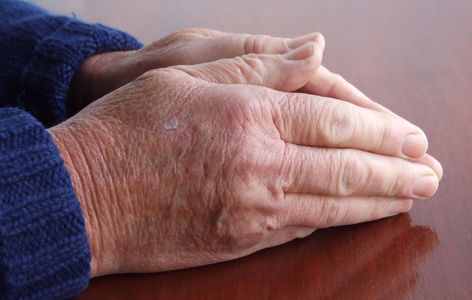
While a slight tremor in the hand may be attributed to Parkinson disease, it could also be a symptom of other neurological diseases such as stroke.
Currently clinicians diagnose individuals with Parkinson disease (PD) based on their clinical symptoms. This occurs at later stages of the disease when the brain cells that control movement have already been killed due to the accumulation of abnormal clumps of a protein known as alpha-synuclein (aSyn). As a result, researchers have been trying to develop a test that can diagnose the disease earlier, when treatments might be more effective.
Several studies have shown that the presence of aSyn protein in the colon can be used to distinguish patients with PD. However, a new study led by UHN Researcher Dr. Lili-Naz Hazrati, which looked at the expression of aSyn in patients with and without PD, has raised serious concerns about these findings.
Dr. Hazrati and her team developed a staining technique that detects clumps of aSyn with greater sensitivity than those currently used. They used this technique to evaluate the levels of aSyn in patients with PD and compared the results to those of patients without any symptoms of the disease. Their analysis showed that even though tissues from patients with PD were more likely to express aSyn, patients without any symptoms for PD also had aSyn protein clumps present in their colons.
Explains Dr. Hazrati, "Our study provides strong evidence that levels of aSyn in the colon are not indicative of Parkinson disease. However, because levels of the protein are higher in individuals with PD, it remains to be determined if aSyn could be utilized as a biomarker when combined with other clinical tests."
This work was supported by Parkinson Society Canada and the Toronto General & Western Hospital Foundation.
Colonic mucosal α-synuclein lacks specificity as a biomarker for Parkinson disease. Visanji NP, Marras C, Kern DS, Al Dakheel A, Gao A, Liu LW, Lang AE, Hazrati LN. Neurology. 2015 Jan 14. [Pubmed abstract]
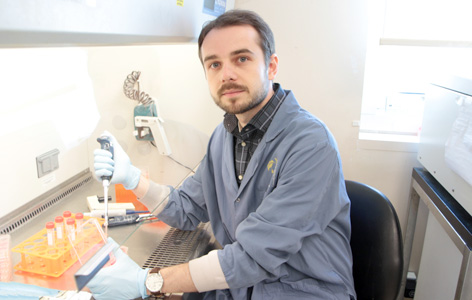
 TRI Senior Scientist, Dr.
TRI Senior Scientist, Dr.  PM Clinical Researcher Dr.
PM Clinical Researcher Dr.  It was recently announced that Dr. Badru Moloo, Director of UHN's Animal Resources Centre (ARC), is the recipient of the 2015 Charles River Award from the Canadian Association for Laboratory Animal Medicine (CALM/ACMAL). It is the organization's most prestigious award and it honours exemplary contributions by a veterinarian towards the field of laboratory animal medicine and welfare. The award will be presented to Dr. Moloo at the organization's 54th Annual Symposium to be held in Montréal, Quebec. As ARC Director, Dr. Moloo supervises the logistical demands and needs of researchers using animal models at UHN and maintains the highest standards of ethical care.
It was recently announced that Dr. Badru Moloo, Director of UHN's Animal Resources Centre (ARC), is the recipient of the 2015 Charles River Award from the Canadian Association for Laboratory Animal Medicine (CALM/ACMAL). It is the organization's most prestigious award and it honours exemplary contributions by a veterinarian towards the field of laboratory animal medicine and welfare. The award will be presented to Dr. Moloo at the organization's 54th Annual Symposium to be held in Montréal, Quebec. As ARC Director, Dr. Moloo supervises the logistical demands and needs of researchers using animal models at UHN and maintains the highest standards of ethical care.